

使用 Docker 和 HuggingFace 实现 NLP 文本情感分析应用
source link: https://soulteary.com/2022/09/30/nlp-text-sentiment-analysis-application-using-docker-and-huggingface.html
Go to the source link to view the article. You can view the picture content, updated content and better typesetting reading experience. If the link is broken, please click the button below to view the snapshot at that time.
使用 Docker 和 HuggingFace 实现 NLP 文本情感分析应用
在继续分享“干燥、有趣”的向量数据库实战内容之前,我们来聊一篇简单有趣的内容:如何使用 Docker 和 HuggingFace 现成的模型,快速实现一个 NLP 文本情感分析应用,支持中英文内容的情感快速分析。
在这篇文章里,我们不需要准备显卡和语料,也不需要耐心等待“炼丹”就绪,只要会“搭积木”,就能够实现这样一个有趣的小工具。
本篇内容,作为后续内容的前置内容(工具),我们来聊聊如何将 HuggingFace 模型使用 Docker 封装为 AI 应用。出于一些原因,我希望能够对数据进行情感分析判断,然而目前并没有简单好用的工具可以帮助我实现这个事情,尤其是我的数据更多是基于中文数据、HuggingFace 上开源开放、允许低资源量运行的模型更多是基于英文数据训练而成。为了简单的解决这个问题,我将 HuggingFace 上的两个模型组合在了一起,用一个偷懒的办法,解决了“中文数据在英文模型”中使用的问题。
早些时候,分享过的两篇内容《使用 Docker 来运行 HuggingFace 海量模型 》 、《用让新海诚本人惊讶的 AI 模型制作属于你的动漫视频》里,有聊过使用 Docker、Towhee 来将 HuggingFace 模型快速转变为 AI 应用,如果你对图像处理感兴趣,可以翻阅这两篇内容。
想要愉快的阅读和跟着本文游玩,需要 Docker 以及 Python 环境,可以参考上面两篇文章,或者《在笔记本上搭建高性价比的 Linux 学习环境:基础篇》文章完成基础环境的准备,再次就不过多赘述了。
先来看下最终实现效果,一个简单的界面中,我们只要输入内容,就能够得到内容对应的情感分析:
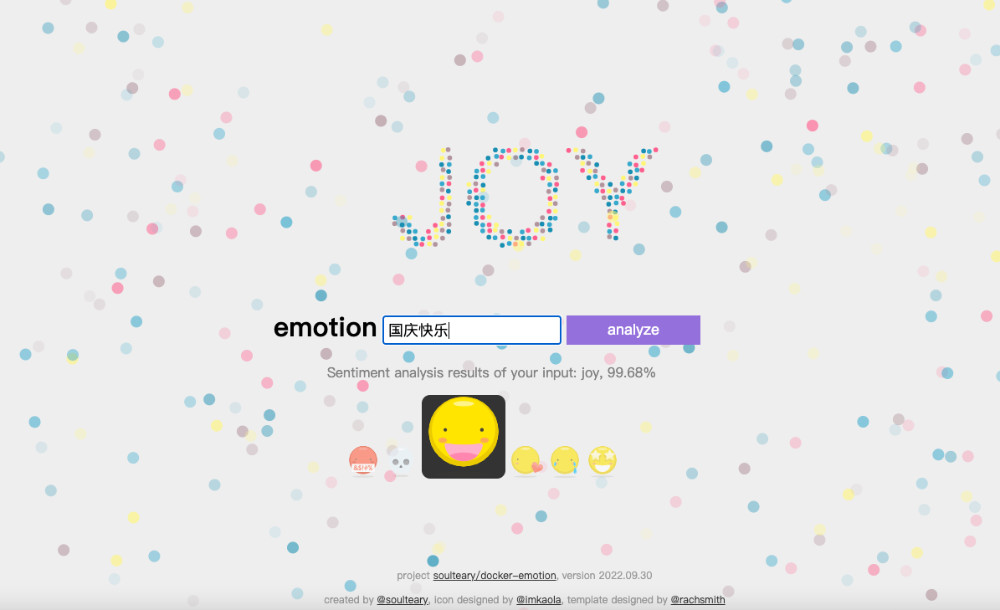
当然,因为我选择的模型是预训练模型,考虑到资源消耗,也并没有使用参数量更大的大模型,所以精度和分类不见得 100% 准确,不过经过测试,多数情况下,这个应用是能够满足我后续文章的需要的,如果你有更高的要求,可以参考本文进行模型替换,:D
如果你着急想试玩这个应用,可以通过下面的 Docker 命令,快速启动它:
docker run --rm -it -p 3000:3000 soulteary/emotion:2022.09.30
打开浏览器,输入 http://localhost:3000 ,就能够看到效果啦。
接下来,我们来看看这样的一个应用是如何实现的。
第一步:实现基础的文本分析功能
我在 HuggingFace 上找到了一个效果还不错的预训练模型:bhadresh-savani/bert-base-uncased-emotion。它是基于“镇站之宝”,上个月下载量有三千三百万之多的 bert-base-uncased 基础上优化得出的,这个模型在英文内容的情感分析准确率能够达到 94%,看起来还是比较不错的。
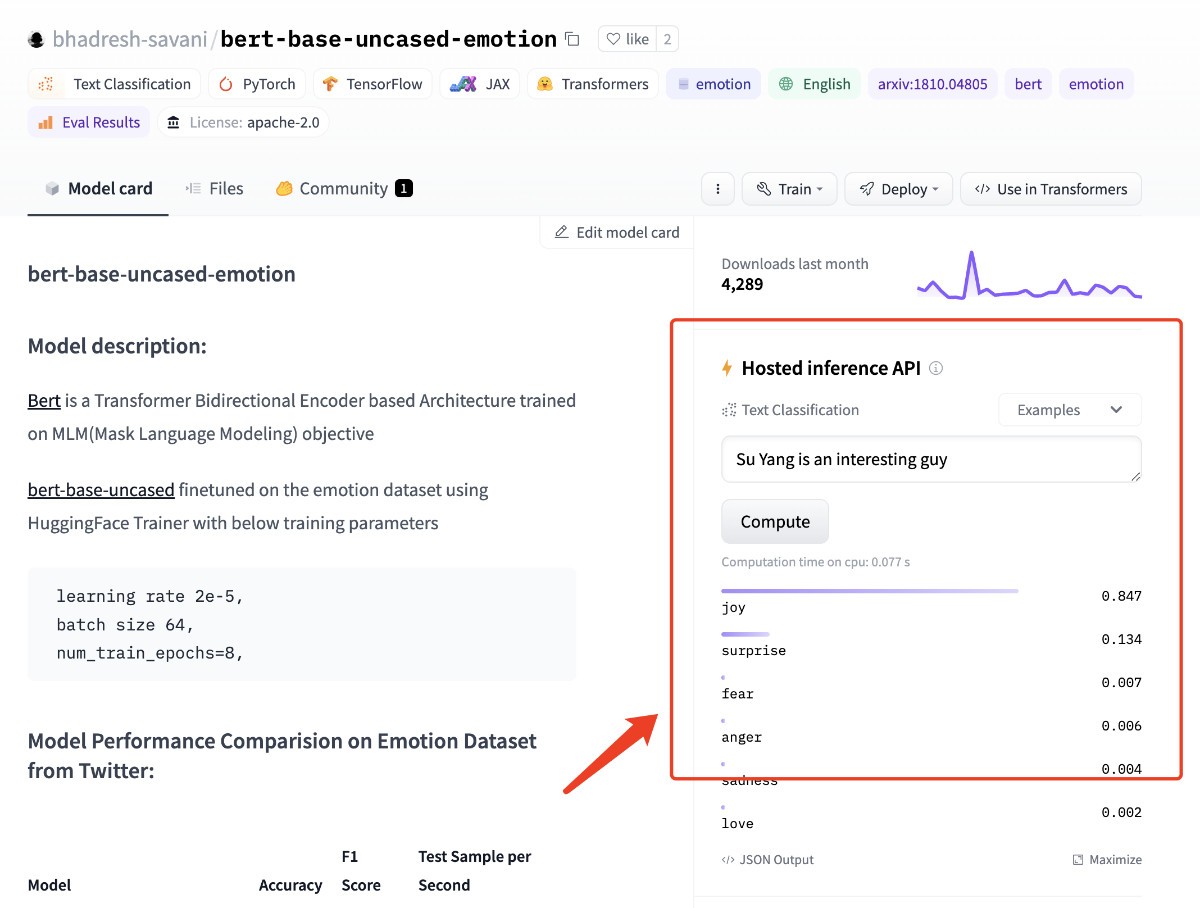
模型论文基于 Google Research 团队在 2019 年公开发表的 “BERT: Pre-training of Deep Bidirectional Transformers for Language Understanding” 论文实现。在 HuggingFace 的模型仓库里,基于这篇论文的实现足足有111个之多,侧面说明其靠谱程度。
封装文本分析模型的运行容器环境
想要运行这个模型,我们需要先完成基础依赖的安装:transformers 和 torch,如果你的本地有 PyTorch,可以跳过安装 torch 这个依赖的安装。
为了确保读者不论是否有“显卡”都能运行这个程序,这里选择安装小巧的 CPU 版本。你也可以访问 PyTorch 官方网站,选择适合自己的安装方式:
pip install transformers==4.22.2 && \
pip install torch==1.12.1+cpu --extra-index-url https://download.pytorch.org/whl/cpu
我们参考模型项目文档中的例子,不难写出下面的示例代码,来验证“情感分析”功能。测试文本,我们就选择“Good Good Study, Day Day Up”吧 :-D
from transformers import pipeline
classifier = pipeline("text-classification",model='bhadresh-savani/bert-base-uncased-emotion', top_k=1)
prediction = classifier("Good Good Study, Day Day Up", )
print(prediction)
将上面的代码保存为 app.py,执行 python app.py,不出意外,我们将得到类似下面的输出结果,是不是分析情绪结果还挺准的?
[[{'label': 'joy', 'score': 0.994911253452301}]]
在确认模型和程序都没问题之后,我们来封装镜像,确保程序能够在容器中被正常运行。
FROM python:3.9-slim-buster
LABEL [email protected]
RUN sed -i -E "s/\w+.debian.org/mirrors.tuna.tsinghua.edu.cn/g" /etc/apt/sources.list
RUN pip config set global.index-url https://pypi.tuna.tsinghua.edu.cn/simple && \
pip3 install --upgrade pip && \
pip install transformers==4.22.2 && \
pip install torch==1.12.1+cpu --extra-index-url https://download.pytorch.org/whl/cpu && \
pip cache purge
RUN python -c "from transformers import pipeline; pipeline('text-classification',model='bhadresh-savani/bert-base-uncased-emotion', top_k=1)" && \
python -c "import transformers; transformers.utils.move_cache()"
WORKDIR /app/
COPY ./docker/bert-base-uncased-emotion/app.py ./
CMD ["python", "app.py"]
为了能够让容器中的程序运行更高效,我在容器中添加了一条简单的命令,让程序在容器中先进行“预热”,将需要的模型资源提前下载,保存在镜像中。避免每次运行容器都需要下载几百兆的镜像,浪费时间。
保存好 Dockerfile 之后,执行 docker build -t soulteary/bert-base-uncased-emotion:2022.09.30 -f docker/bert-base-uncased-emotion/Dockerfile . ,完成基础运行环境的容器镜像构建。
然后,运行容器验证模型程序是否能够正常运行:
docker run --rm -it soulteary/bert-base-uncased-emotion:2022.09.30
# 运行结果
[[{'label': 'joy', 'score': 0.994911253452301}]]
这部分的完整代码,我上传到了 soulteary/docker-emotion/docker/bert-base-uncased-emotion,有需要可以自取。
第二步:实现基础的文本翻译功能
和上文中挑选情绪分析模型一样,想要实现中文翻译为英文,同样需要先找一个效果还不错的模型。
经过简单的站内搜索,我找到了下面三个模型,为了验证模型效果,我写了一句比较无厘头的测试内容,对这些模型进行测试:“ 张无忌抄起一张板凳,将成昆拍晕了过去。 ”
- Helsinki-NLP/opus-mt-zh-en
- 赫尔辛基大学出品,上个月下载量十万+,不过 PyTorch 模型最后更新时间是两年前。
- 直接使用在线页面,测试模型翻译结果:“One unsuspecting copying of a stool will make Quin faint.”
- K024/mt5-zh-ja-en-trimmed
- 基于谷歌 google/mt5-base 微调而来的模型,上个月累计下载量两千四百余次,PyTorch 模型上一次修改是七个月前。
- 经过模型推理得到的翻译结果是:“Zhang took a bench and took Cheng Kun over.”
- penpen/novel-zh-en
- 一个项目 ReadME 目前还是“三无”状态的模型,上个月下载量六百余次,PyTorch 模型上一次修改是接近一个月前。
- 翻译结果:“Zhang Wuji picked up a stool and knocked Cheng Kun unconscious.”
在反复测试、对比几次之后,我个人感觉最后一个模型更对我的胃口。那么就基于它来实现应用功能吧。还是先来实现基础的模型能力,“翻译”功能相关的程序。
想要让模型正确运行,我们除了需要安装“情感分析”模型需要的 transformers 和 torch 之外,还需要安装下面两个依赖:
pip install pip install sentencepiece==0.1.97 sacremoses==0.0.53
还是老样子,简单写几行代码,来完成模型的调用,验证程序是否能够正常运行:
from transformers import pipeline
translator = pipeline("translation", model="penpen/novel-zh-en", max_time=7)
prediction = translator("张无忌抄起一张板凳,将成昆拍晕了过去。", )[0]["translation_text"]
print(prediction)
将上面的代码保存为 app.py,然后执行 python app.py,顺利的情况下,我们将得到下面的结果:
Zhang Wuji picked up a stool and knocked Cheng Kun unconscious.
同样,在确认模型和程序都没问题之后,我们来封装镜像,确保程序能够在容器中被正常运行。
封装翻译模型的运行容器环境
我们对之前的模型镜像文件进行简单调整:
FROM python:3.9-slim-buster
LABEL [email protected]
RUN sed -i -E "s/\w+.debian.org/mirrors.tuna.tsinghua.edu.cn/g" /etc/apt/sources.list
RUN pip config set global.index-url https://pypi.tuna.tsinghua.edu.cn/simple && \
pip3 install --upgrade pip && \
pip install transformers==4.22.2 sentencepiece==0.1.97 sacremoses==0.0.53 && \
pip install torch==1.12.1+cpu --extra-index-url https://download.pytorch.org/whl/cpu && \
pip cache purge
RUN pip install pip install sentencepiece sacremoses && \
pip cache purge
RUN python -c "from transformers import pipeline; translator = pipeline('translation', model='penpen/novel-zh-en', max_time=7)" && \
python -c "import transformers; transformers.utils.move_cache()"
WORKDIR /app/
COPY ./docker/novel-zh-en/app.py ./
CMD ["python", "app.py"]
然后执行 docker build -t soulteary/novel-zh-en:2022.09.30 -f docker/novel-zh-en/Dockerfile . 构建这个模型的镜像。完成构建之后,我们同样运行一下容器,确保构建的镜像没有问题:
docker run --rm -it soulteary/novel-zh-en:2022.09.30
# 运行结果
Zhang Wuji picked up a stool and knocked Cheng Kun unconscious.
这部分的完整代码,我上传到了 soulteary/docker-emotion/docker/novel-zh-en,有需要可以自取。
步骤三:初步实现简单的 Web AI 应用
在搞定了核心功能之后,我们来使用偷懒神器 gradio (pip install gradio==3.4.0),实现一个简单的 Web AI 应用,让刚刚模型的“翻译能力”和“分析能力”组合到一起。
import gradio as gr
from transformers import pipeline
classifier = pipeline("text-classification", model="bhadresh-savani/bert-base-uncased-emotion", top_k=1)
translator = pipeline("translation", model="penpen/novel-zh-en", max_time=7)
def analytics_emo(x):
data = classifier(x)[0]
return data
def predict(text):
translation = ""
split_text = text.splitlines()
for text in split_text:
text = text.strip()
if text:
if len(text) < 512:
sentence = translator(text)[0]["translation_text"] + "\n\n"
translation += sentence
print(split_text)
else:
for i in range(0, len(text), 512):
if i + 512 > len(text):
sentence = translator(text[i:])[0]["translation_text"]
else:
sentence = translator(
text[i: i + 512])[0]["translation_text"]
translation += sentence
return translation
with gr.Blocks() as demo:
gr.Markdown("<center><h1>内容情感分析</h1> 一个简单的文本情感分析工具</center>")
with gr.Tab("情感分析"):
with gr.Row():
with gr.Column(scale=1, min_width=600):
translate_input = gr.Textbox(label="文本内容", lines=4, max_lines=100, placeholder="等待分析的文本内容...")
translate_button = gr.Button("翻译")
translate_hidden = gr.State("")
translate_output = gr.Textbox(label="分析结果", lines=4, max_lines=100, placeholder="分析结果...")
analytics_button = gr.Button("一窥究竟")
text_output = gr.Textbox(label="结果", lines=10, max_lines=100, placeholder="分析结果...")
translate_button.click(predict, api_name="translate", inputs=[translate_input], outputs=translate_output)
analytics_button.click(analytics_emo, api_name="analytics", inputs=translate_output, outputs=text_output)
demo.launch(debug=True, server_name="0.0.0.0")
代码逻辑比较简单,把前文中的“计算”部分包装为函数,结合 gradio 中的 UI 组件调用即可,将代码保存为 interfaces.py,然后执行 python interfaces.py,等待终端输出日志:
Running on local URL: http://0.0.0.0:7860
To create a public link, set `share=True` in `launch()`.
然后打开浏览器,访问 http://0.0.0.0:7860,就能够看到下面的界面啦,随便输入点什么,测试下功能。
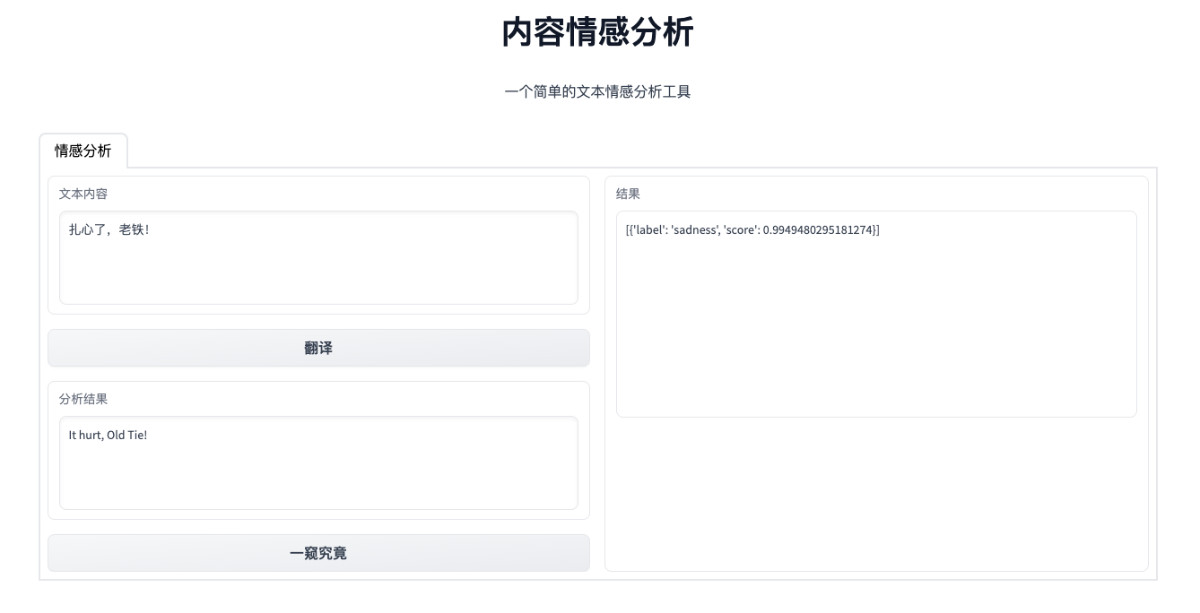
这部分的完整代码上传到了 soulteary/docker-emotion/docker/web/interfaces.py。
步骤四:优化 Web AI 应用实现
在完成 Web 应用功能验证之后,为了使用体验更好,还有一些需要改善的地方:
- 将两个模型能力完全结合到一起,实现输入中文或英文内容,直接能够分析内容的情感,而不需要先“翻译”后“分析”。
- 应用目前只能够提供 Web 界面访问,如果我们想要通过 API 实现批量数据转换,会比较麻烦。
- 为了使用更简单,我们需要完成最终容器的封装。
我们先来改进程序,让两个模型的能力“完全合体”:
import gradio as gr
from transformers import pipeline
classifier = pipeline("text-classification", model="bhadresh-savani/bert-base-uncased-emotion", top_k=1)
translator = pipeline("translation", model="penpen/novel-zh-en", max_time=7)
def doAnalytics(input):
return classifier(doTranslate(input))[0]
def doTranslate(text):
translation = ""
split_text = text.splitlines()
for text in split_text:
text = text.strip()
if text:
if len(text) < 512:
sentence = translator(text)[0]["translation_text"] + "\n\n"
translation += sentence
print(split_text)
else:
for i in range(0, len(text), 512):
if i + 512 > len(text):
sentence = translator(text[i:])[0]["translation_text"]
else:
sentence = translator(
text[i: i + 512])[0]["translation_text"]
translation += sentence
return translation
with gr.Blocks() as demo:
gr.Markdown("<center><h1>内容情感分析</h1> 一个简单的文本情感分析工具</center>")
with gr.Tab("情感分析"):
with gr.Row():
with gr.Column(scale=1, min_width=600):
input = gr.Textbox(label="文本内容", lines=4, max_lines=100, placeholder="等待分析的文本内容...")
with gr.Row():
analytics_button = gr.Button("一窥究竟")
translate_button = gr.Button("翻译内容")
output = gr.Textbox(label="分析结果", lines=4, max_lines=100, placeholder="分析结果...")
analytics_button.click(doAnalytics, api_name="analytics", inputs=[input], outputs=output)
translate_button.click(doTranslate, api_name="translate", inputs=[input], outputs=output)
demo.launch(debug=True, server_name="0.0.0.0")
将上面的内容保存为 app.py 之后,执行 python app.py,来验证程序。等待程序运行完毕,访问 http://0.0.0.0:7860,就能够看到更清爽简单的界面啦。
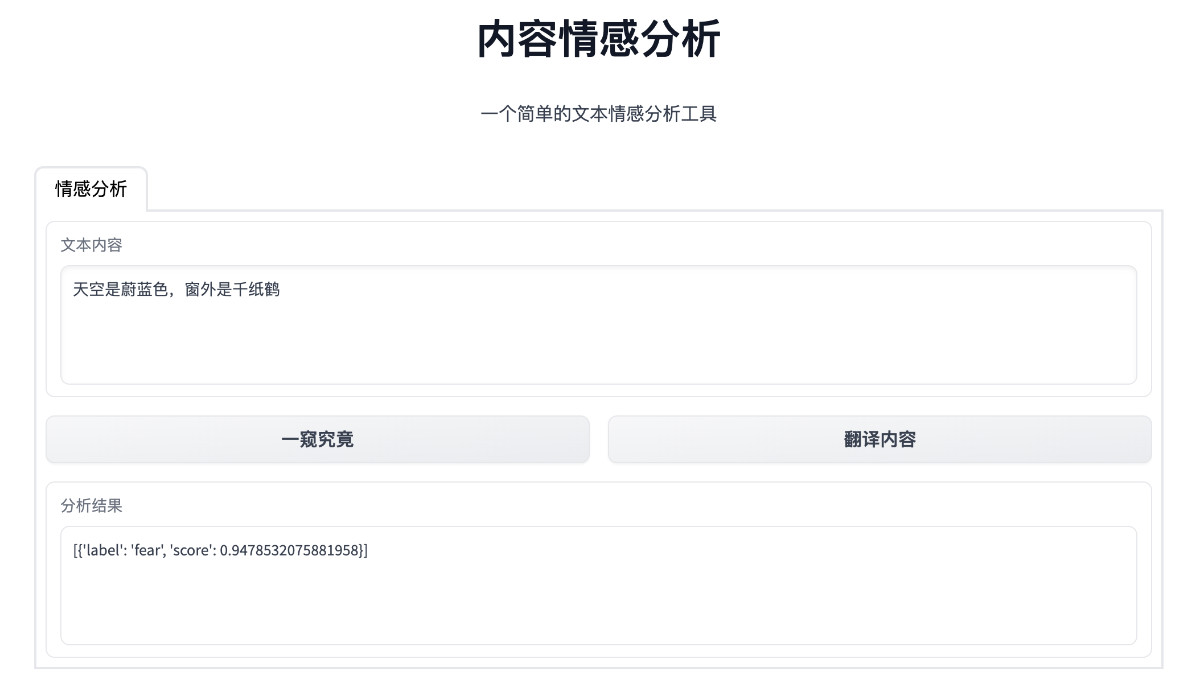
想要让应用具备 API 调用能力,最简单的方法是用 gradio 提供的 API 能力,使用方法很简单,在 UI 组件的字段里添加 api_name 指定接口名称即可:
analytics_button.click(doAnalytics, api_name="analytics", inputs=[input], outputs=output)
translate_button.click(doTranslate, api_name="translate", inputs=[input], outputs=output)
我们可以参考上面的实现,来完成应用接口的声明,重新使用 python app.py 启动应用,就能够使用下面的方式来调用接口,使用不同的模型的能力啦:
curl http://localhost:7860/api/translate --data-raw '{"data":["扎心"]}' -X POST -H 'Content-Type: application/json'
# 返回结果
# {"data":["It was piercing.\n\n"],"is_generating":false,"duration":0.5533111095428467,"average_duration":0.6110006173451742}
curl http://localhost:7860/api/analytics --data-raw '{"data":["扎心"]}' -X POST -H 'Content-Type: application/json'
# 返回结果
# {"data":["[{'label': 'anger', 'score': 0.8803150057792664}]"],"is_generating":false,"duration":0.6281025409698486,"average_duration":0.61610213915507}%
封装通用的模型运行基础容器环境
在聊最终应用的封装之前,我们先来看看如何进行更为完整的基础镜像的封装。结合上文的实践,不难看出两个模型的基础运行环境有一部分是完全相同的,所以我们可以得到一个能够让两个模型都正常运行的,相对最小化的基础 Docker 镜像:
FROM python:3.9-slim-buster
LABEL [email protected]
RUN sed -i -E "s/\w+.debian.org/mirrors.tuna.tsinghua.edu.cn/g" /etc/apt/sources.list
RUN pip config set global.index-url https://pypi.tuna.tsinghua.edu.cn/simple && \
pip3 install --upgrade pip && \
pip install transformers==4.22.2 sentencepiece==0.1.97 sacremoses==0.0.53 && \
pip install torch==1.12.1+cpu --extra-index-url https://download.pytorch.org/whl/cpu && \
pip cache purge
RUN python -c "from transformers import pipeline; translator = pipeline('translation', model='penpen/novel-zh-en', max_time=7)" && \
python -c "from transformers import pipeline; pipeline('text-classification',model='bhadresh-savani/bert-base-uncased-emotion', top_k=1)" && \
python -c "import transformers; transformers.utils.move_cache()"
WORKDIR /app/
将上面的内容保存为 Dockrfile.base 之后,执行 docker build -t soulteary/emotion:base-2022.09.30 -f docker/web/Dockerfile.base . 就完成了基础环境的构建。
步骤四:实现一个漂亮的前端应用
虽然 gradio 提供的 Web UI 看起来干净简洁,但是模型分析情感的响应结果是一串 JSON 字符串,终究没有一个更直观的界面看起来直观,用起来舒服。
所以,我用网上的素材进行了调整,实现了一个简单的前端界面。
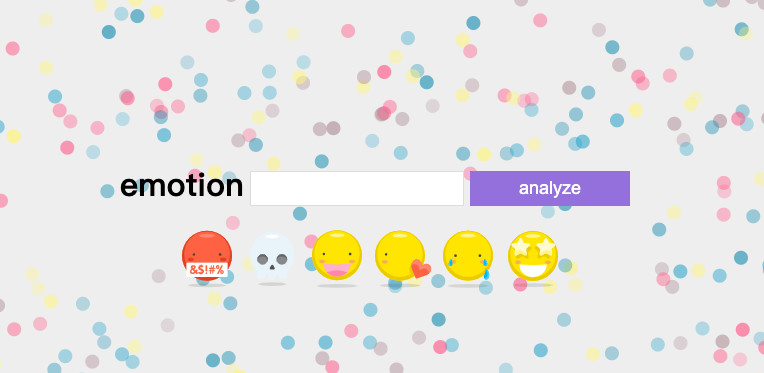
因为 gradio 不能处理复杂的自定义界面,所以我们需要参考上一篇文章《向量数据库入坑:使用 Docker 和 Milvus 快速构建本地轻量图片搜索引擎》中,“使用 Golang 实现小而强大的应用网关”的方式,来完成一个简单的 Web 服务,让用户能够通过浏览器访问到这个前端界面,并且能够正确的将需要分析的数据传递给 gradio 启动的服务。
这里包含的内容比较多,就不一一展开了,完整代码可以参考 soulteary/docker-emotion/docker/ui 这里,具体的技巧,在上一篇文章中有提,如果还不熟悉的同学可以移步阅读。
在实现完毕“前端界面”和 Go 提供的“前端服务”之后,我们将服务使用容器方式进行构建,就能够实现最终的工具镜像了。
步骤五:实现最终应用和容器镜像
为了实现一个“All in One”,开箱即用的容器应用,我选择和上一篇文章中“在 Docker 容器中配置 supervisor”所述一样,使用 supervisor 来进行最终容器的构建。
FROM soulteary/emotion:ui-2022.09.30 AS WEBUI
FROM soulteary/emotion:base-2022.09.30
LABEL [email protected]
RUN pip install gradio==3.4.0 && \
pip cache purge
COPY docker/web/*.py ./
CMD ["python", "app.py"]
RUN apt update && apt install supervisor -y && \
apt-get remove --purge -y && rm -rf /var/lib/apt/lists/*
SHELL ["/bin/bash", "-c"]
RUN echo $' \n\
[unix_http_server] \n\
file=/var/run/supervisor.sock \n\
chmod=0700 \n\
[inet_http_server] \n\
port=0.0.0.0:8080 \n\
[supervisord] \n\
nodaemon=true \n\
logfile=/var/log/supervisor/supervisord.log \n\
pidfile=/var/run/supervisord.pid \n\
childlogdir=/var/log/supervisor \n\
[rpcinterface:supervisor] \n\
supervisor.rpcinterface_factory = supervisor.rpcinterface:make_main_rpcinterface \n\
[supervisorctl] \n\
serverurl=unix:///var/run/supervisor.sock \n\
[program:server] \n\
directory=/app \n\
command=python app.py \n\
[program:webui] \n\
command=/app/web \n\
'> /etc/supervisor/supervisord.conf
CMD ["/usr/bin/supervisord","-c","/etc/supervisor/supervisord.conf"]
COPY --from=WEBUI /web /app/web
在编写完毕 Dockerfile 之后,我们执行命令 docker build -t soulteary/emotion:2022.09.30 -f docker/web/Dockerfile .,片刻之后,就能够得到最终的应用镜像了。接着,我们使用命令启动镜像:
docker run --rm -it -p 3000:3000 -p 7860:7860 soulteary/emotion:2022.09.30
然后,在浏览器中访问 3000 端口,就能够看到文章一开始展示的应用界面啦。如果希望了解过程中内容被翻译成了什么样子,可以访问 7860 端口,通过 gradio 提供的界面来了解模型执行过程中的阶段结果。
这篇内容就先写到这里啦,祝大家国庆假期快乐。
Recommend
About Joyk
Aggregate valuable and interesting links.
Joyk means Joy of geeK